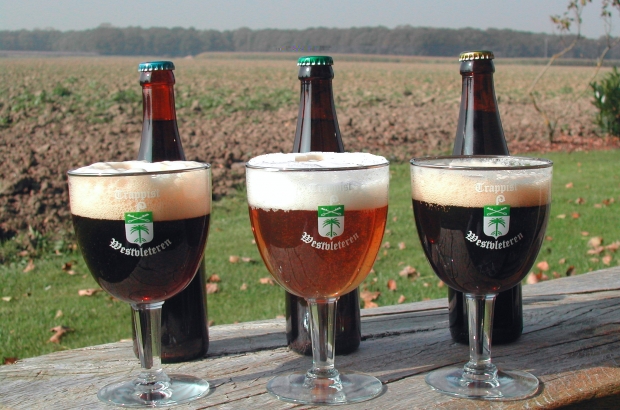- Daily & Weekly newsletters
- Buy & download The Bulletin
- Comment on our articles
Top of the hops
Up north
As luck would have it, Flanders has exactly half of the six recognised Trappist brewers in Belgium: the abbeys of Westmalle, Westvleteren and Achel. Their production, however, is much less than half: about 130,000 hectolitres compared to 186,000 in Wallonia. Of the three, Westvleteren is the most renowned, and in recent years the monks have imposed buying conditions, including reservation and a limit of two crates per customer, simply to meet demand.
Outside the cloistered world of the Trappists, there is a great range of beers in Flanders. Among those considered well worth a detour to find are Tripel Karmeliet from Bosteels brewery in Buggenhout, made with three cereals including oats, to give a distinctive, refreshing and very pleasing beer. Duvel by Duvel-Moortgat of Puurs is a light, golden and extremely drinkable blonde ale with a mule’s kick, so go slowly and try to keep count. The red ale Rodenbach from West Flanders is sour and fruity and goes perfectly with fresh grey shrimp. The geuze and kriek from the Brussels brewery Cantillon are miles away from the syrup-flavoured versions offered by others: made according to time-honoured tradition, they’re an expert balance of fruit and sourness. At the dark end of the spectrum, another Brussels brewery, Brasserie de la Senne, offers the Zwarte Piet and Stouterik, both dry and hoppy, dark and deep in flavour but not heavy.
Other names to look out for: Zinnebir, Taras Boulba and Jambe-de-Bois, also by Brasserie de la Senne; Delirium Tremens from Huyghe in Melle, whose name is not at all misleading; wheat beer from Hoegaarden, Brugs or Dentergem. Up-and-coming names include De Ranke from Ghent with a super-hopped IPA-style beer called XX; and Anders, whose name means ‘otherwise’, from Halen in Limburg. AH
Down south
From surviving Trappist beers to traditional recipe abbey brews and local microbreweries, Wallonia is justifiably proud of its prowess for producing the mythological ambrosia. Breweries of all sizes are growing and consumption is on the rise as consumers seek out diversity and an individual taste.
The three remaining Trappist beers in Wallonia – Orval (Luxembourg), Chimay (Hainaut) and Rochefort (Namur) – are brewed according to custom within monastery walls by or under the control of monks who do not profit from their sale. Dating from the Middle Ages and first produced for self-sufficiency, they are usually dark amber or brown, sometimes slightly sweet and always strong in alcohol (6 to 13%). Flavours include deep, dark, bitter, fruit, hop, spice and caramel. The natural brews are revered for their artisan quality, fairtrade production and distinctive character.
Also arising from monasteries’ need for self-sufficiency are abbey beers. Although brewed to less rigid standards than their Trappist counterparts, they usually also offer double, triple and brown beers in addition to ambers and blondes. Whether from microbreweries or international mega-breweries, they are brewed to traditional recipes under commercial arrangement with the abbey or former abbey. The variety comes from the custom of monks to brew the strongest beer for their own consumption, the second for their local customers and the weakest for domestic servants. Popular names are Maredsous, Floreffe, Bonne Espérance, St Feuillien, Villers-la-Ville and Du Bocq.
It seems as though every village and town in Wallonia has a local brew. Beer-tasting experiences abound, and it would be virtually impossible to sample every one. From fruity krieks and hoppy whites to sour lambic gueuzes, there is a tipple for every taste. Among the well-known are Tilquin gueuzerie (Walloon Brabant), award-winning Dubuisson (Hainaut), Brasserie du Bocq (Namur), and the small but award-winning Blehen (Liège). SC
Malheur may mean misfortune in French, but the brewery’s tipples are topper among Belgian beer fanatics
The rise of small Belgian brewers seems unstoppable. In the US, beer-lovers are standing in line for hours to get their hands on a single bottle of Westvleteren, a Trappist from a small abbey near Ypres. In Tokyo, you can find more than 70 Belgian beers, while Italy imports container after container of Belgian brews. What’s the secret? We talk to Manu De Landtsheer, owner, CEO and master brewer at Malheur, a small Belgian brewery in Buggenhout, East Flanders.
Is Malheur a large brewery?
No, we produce about 7,500 hectolitres a year and have six employees, which makes us one of the smaller medium-sized breweries. Large breweries produce more than 100,000 hectolitres; home brewers typically less than 1,000.
What distinguishes Belgian beers and makes them so well-respected?
One of the key elements is a centuries-long tradition of diversity and small-scale operation. Every brewer is a small island in his own home town. Where this would be disastrous for other industries, it has allowed Belgian brewers to master every type of beer available, from those with high and low yeast contents to trippel Trappist, ambers and geuze, with its spontaneous open-air fermentation. And we keep on searching for new challenges.
It was recently established that Belgium had about 1,250 beers. What new challenges still exist in brewing?
Our local knowhow allows us to continually develop new methods and tastes. In our own brewery, for example, we have created a blonde beer with high yeast content that we re-fermented in champagne bottles and finished in the Champagne region. We export about 75% of our Malheur Brut to the US, and can hardly keep up with demand.
What advice do you have for a novice beer taster entering the world of Belgian brewers?
Just as our brewery does, take small steps, keep focused and never forget that beer and conviviality go hand in hand.
This article was first published in Newcomer Magazine, September 2013




















Comments
and to think that my friends back home in the US wonder why I would want to live in Belgium???
So many beers... So little time!...